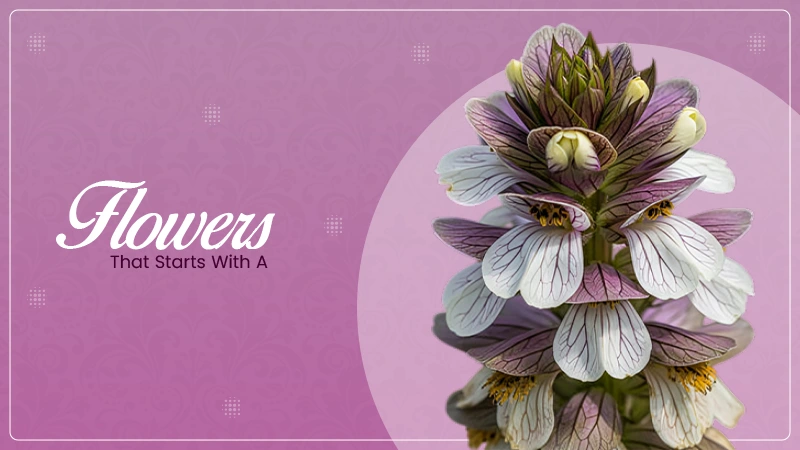Pouty orange blooms swimming in the glossy green foliage – that’s the definition of a goldfish plant!
Being a powerful symbol of money and fortune, the goldfish flower is a must to grow in every home. Give these indoor plants a bright, warm spot by your window, and they’re ready to turn the heads of every passerby.
In this article, get yourself acquainted with all the goldfish plant varieties, care tips, and requirements.
Getting Acquainted With the Goldfish Plant
Goldfish plant is a relatively long-living perennial with a stunning tubular bloom that resembles a ‘pouting goldfish’ swimming in the water. These green pals love to accommodate any given space, be it a hanging basket, or a planter on your windowsill.
However, don’t fall for their glossy, succulent-like appearance! Being native to the Caribbean and Central America, Goldfish plants are completely tropical. They enjoy a fair share of moisture and humidity in their surroundings.
Before diving deep, let’s take a quick stroll through its basic characteristics:
| Botanical Name: | Nematanthus gregarius/ Nematanthus ‘Black Magic’ |
| Common Nickname: | Clog plant, Guppy plant |
| Flower Colors: | Yellow, Red, Orange |
| Plant Type: | Evergreen subshrub, Perennial |
| Maximum Height: | 3 ft. (1 m) |
| Maximum Spread: | 1.6-2 ft. (0.3 m) |
| Lifespan: | 5-10 years |
| Hardiness Zones (USDA): | 10-11 |
| Blooming Season: | From spring to summer |
| Toxicity | Non-toxic to pets and humans |
The features and requirements may vary as per the species, but the goldfish flower remains bright and lively. That being said, let’s discover some species of goldfish plants.
Some Common Goldfish Plant Varieties
With no further delay, here are the pretty goldfish plants that will melt your heart at first glance.
- Nematanthus ‘Tropicana’: This unique species blooms yellow goldfish with red stripes. They also have a reddish tint to their stems and branches.
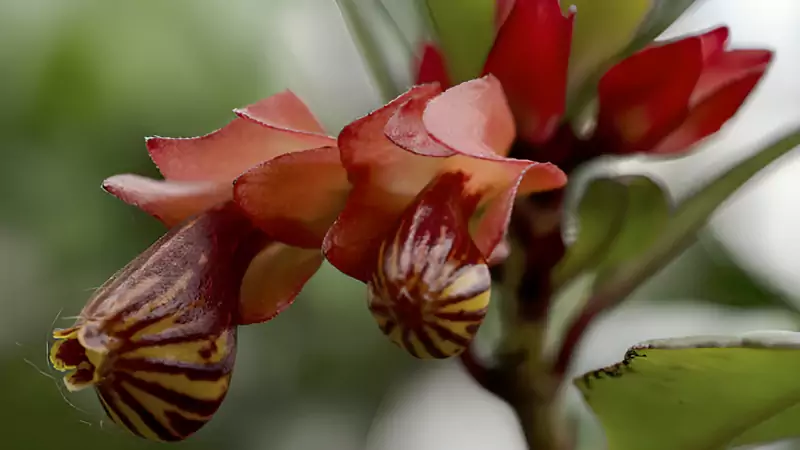
- Nematanthus ‘Green Magic’: With bright orange blooms, this variant features green foliage complemented by bright red patches on leaves.
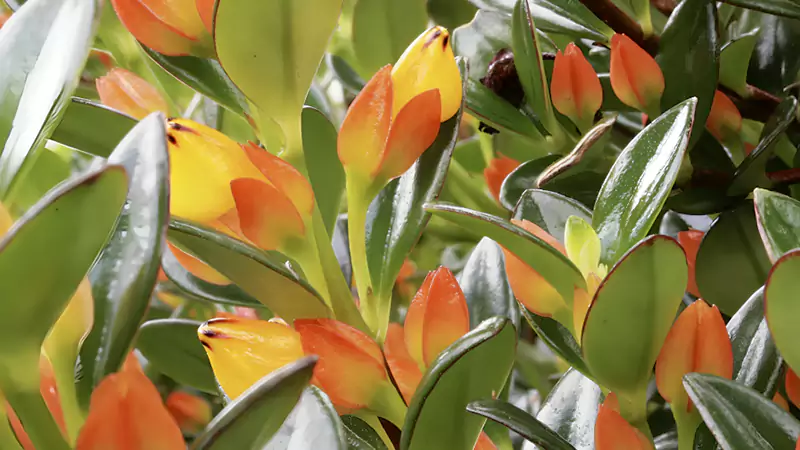
- Nematanthus ‘Black Gold’: Sharply contrasting with its name, ‘Black Gold’ offers glossy leaves with yellowish-orange blooms mixed with a tint of red.
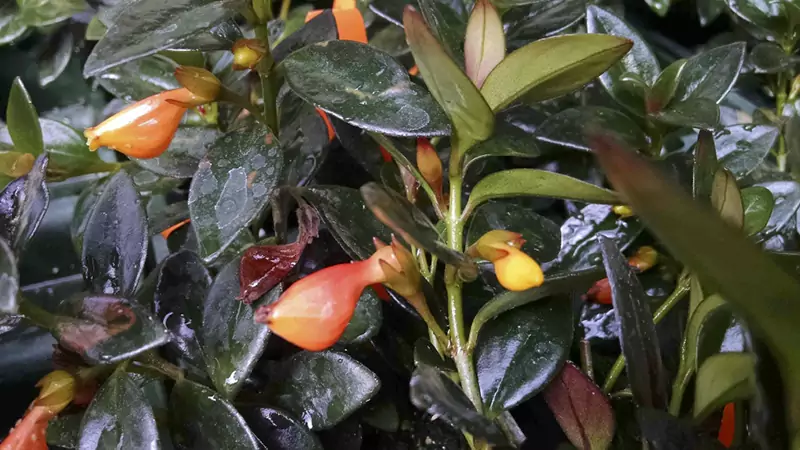
Other Variants of Goldfish Plant
Now, here’s a twist, blooming ‘goldfish’ flowers isn’t a specialty of a single genus! The Columnea genus also features a few blooms that resemble a ‘Flying goldfish’, earning them the nickname of ‘Flying Goldfish plant’.
The more, the merrier. Let’s take a glance at these variants as well:
- Columnea hirta ‘Light Prince’: This particular cultivar has yellow and orange blooms with variegated white and green leaves.
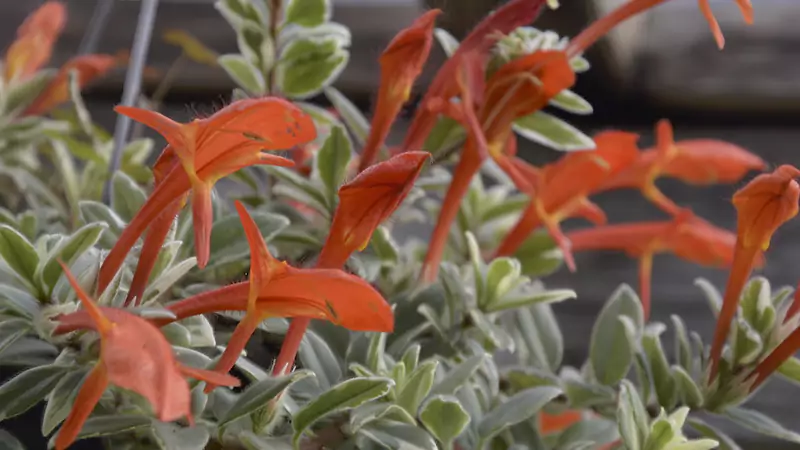
- Columnea ‘Aladdin’s Lamp’: Dark green, close to black, foliage with bright red tubular blooms adorns this variant of Columnea.

- Columnea ‘Chanticleer’: Yellow blooms tipped with shades of red grow amidst the slender, glossy leaves of this species.
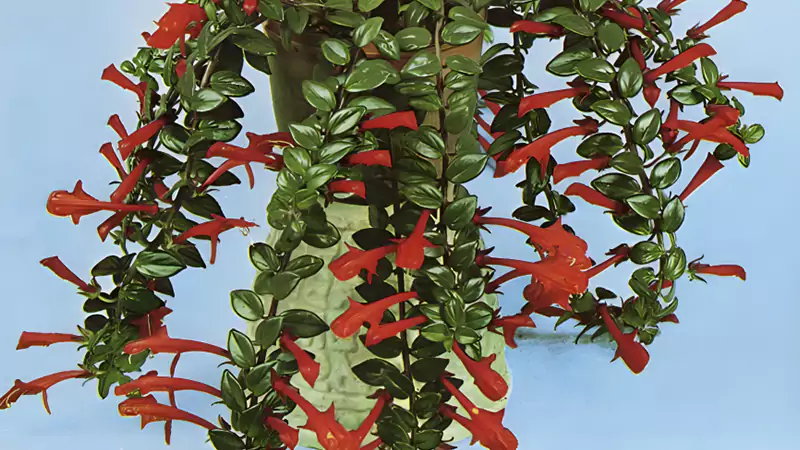
Stunning blossoms require a healthy plant, while a healthy plant requires high nutrition and a favorable environment. To make sure you don’t starve your leafy Pablo of essential needs, read the section below.
How to Care for Goldfish Plants?
The ‘goldfish’ is not a fan of large amounts of water and moisture. Instead, it prefers indirect sunlight, often drying itself completely.
Before bringing this plant home, you should get yourself familiar with the required knowledge. Drive through the below factors to provide the best for your future buddy:
Sunlight Requirements
These plants love a LOT of sunlight, but it is indirect. Direct sunlight may cause them to sunburn, leading to wilting leaves. Keep the plant near an east, west, or north-facing window to provide 4–6 hours of sunlight.
If you notice a lack of flowers, especially during the blooming season, your plant is not getting enough sunlight. Change their position to a brighter area where they receive light throughout the day.
Soil Conditions
Pot them in a mixture of peat moss, perlite, and potting soil. You can opt for chalky, loamy, or sandy soil, but avoid heavy clay soils. Moreover, they can easily tolerate acid, alkaline, or neutral soil
Don’t compress the soil a lot after planting, as goldfish plants prefer being loosely potted. Although they hate being waterlogged, goldfish plants can thrive in moisture. Thus, choose a pot with proper drainage holes to keep the soil moist but well-drained.
Quick Tip!
You can add a layer of mulch at the top of the soil to prevent sail formation, retain moisture, and regulate temperature.
Water Routine
The watering schedule needs to be varied by season, especially in summer and frost. During warmer temperatures, spray water twice a day to keep the soil constantly moist but not soggy.
On colder days, cut back on watering frequency. Wait for the top 1–2 inches of soil to dry before the next watering. However, you can mist the leaves daily to maintain moisture and humidity in the environment.
Quick Tip!
If you notice wrinkly leaves, increase the dosage of water by a little, because it’s a sign of your plant drying.
Fertilization
Add proper fertilization to your watering routine, especially throughout the growing period. You can use both organic manures and man-made fertilizers with the right dosage.
From spring to fall, spray a diluted houseplant fertilizer every two weeks. One of the best substrates to provide is African violet feed, which contains all the required nutrients for most flowering plants.
You can reduce or completely stop fertilization when the plant is in its dormant phase during winter. Remember to spray fertilizer on the soil, not on the plant, unless it’s foliar fertilizer.
Quick Definition!
Foliar fertilizers are low on chemical, or diluted fertilizers. They can be directly sprayed or applied to the leaves to provide instant nutrition. However, not all gardeners support this method.
Favorable Temperature and Humidity
The pretty goldfish lives happily in temperatures between 65-80°F (18-27°C). Do not expose the plant to frequent temperature ups and downs.
Moreover, they are plants that favor high humidity levels, which is not always possible indoors. For that, you can keep a tray filled with beach pebbles and water under the planter.
In the wild, these plants are primarily epiphytes, always attaching themselves to a tall tree for necessary nourishment. However, indoor goldfish plants require keen attention to stay healthy.
Pests and Diseases Preying on Goldfish Plant
Given their succulent-like physique, goldfish plants are resistant to a lot of pests. However, precaution is always better than the cure.
Thus, keep your eyes out for the signs of the below-mentioned pests and diseases that may attack your plant.
- Aphids: These tiny insects can stunt growth because they feed on plant sap. Aphid infestations can be managed with neem oil spray or organic insecticidal soap.
- Mealybugs: Mealybugs are pests, with cotton-like appearance, that suck on plant fluids. Use an insecticidal soap or rub alcohol on the leaves with a cotton swab.
- Whiteflies: Such small, winged insects often harm plants by sucking their sap and leaving a sticky residue. Use spraying products that contain Beauvaria Bassiania as a main component.
- Spider mites: Mites are tiny arachnids that also survive on a plant’s sap. Introduce mite predators like ladybugs to the plant and regularly mist the leaves.
- Fungal diseases: Goldfish plants are prone to fungal diseases like powdery mildew and gray mold. To avoid this, don’t overwater and keep the plant well-ventilated.
- Leaf spot: Brown or black spots often appear on leaves due to bacterial infections. To prevent this, avoid overwatering and treat the plant with bactericide.
- Root rot: It’s another damage that occurs from overwatering or improper draining. Simply ensure to plant it in loosely potted, well-drained soil.
Growing any plant requires dedication to keep it safe and sound from any illness. Offer this goldfish lots of love and care for continuous blooms.
Methods to Grow Goldfish Plants
To start your journey with the Nematanthus goldfish plant, you can buy a semi-grown plant from any nursery or trusted online website. On the other hand, if you wish to grow them from the start, go for the below methods:
By Propagation
The most common way to grow a goldfish plant is by propagating a fresh cutting. Below are the necessary steps to pot a plant by this method:
- From the plant, choose a non-flowering stem that is soft, flexible, and green at the top.
We only require the fresh green part of the stem (2-3 inches), not the brown part, as woody stems will not produce roots.
- Use sterilized scissors (or pruning shears) to cut right below a leaf node at the end of the green stem.
- Remove the lower leaves of the cutting and flower buds, if any.
- Keep these cuttings partly dipped in water to produce roots. It usually takes around 2–3 weeks for the best root development.
- Now, fill a small pot with the right potting mixture and place the cutting in.
- Spray water on the plant and soil to keep it moist.
Then, keep the plant in a location with bright, indirect sunlight. Given the proper nourishment, roots will begin to develop in a few weeks. Once they are well-established, you can repot the plant into a bigger planter.
By Planting Seeds
Another alternative is to purchase seeds of goldfish plants and plant them in the right season, i.e. spring or summer. Take a look at the steps below:
- Soak the seeds in water or a diluted cleaning solution for 1–2 hours.
- Rinse the seeds delicately and place them on a paper towel to dry.
- Take a seed-starting tray and fill it with damp potting soil.
- Place 2–3 seeds in every block and cover them with some soil.
- Mist the tray with some water and cover it with plastic wrap to promote humidity.
- Keep the tray in a place that receives the most bright, indirect sunlight daily.
You can opt for a plant light to maintain a proper temperature of around 68°F to 75°F, as seeds are prone to higher temperature variations. In one to two weeks, your seeds should begin to sprout.
However, this method is not always a pass, as meeting the naturally humid environment of the wild is difficult. Only 20 in 100 plants, grown by this method, thrive in the long run.
To achieve the best results, take extra care of the plant till it reaches a foot in length.
Transplanting an Indoor Goldfish Plant
After the new roots have settled down in the soil, it is a must to change their container for better growth. To ensure a safe transplant, follow the below instructions:
- Choose a pot one or two sizes bigger than your previous one. Create proper drainage holes.
- Fill 1/2 of the container with the suitable potting mix and make a slight hole in the middle of the soil.
- Remove your plant from the old pot and loosen its roots by removing some soil from the bottom.
- Carefully place the plant in the bigger pot and fill in the space with more soil.
- Wet the plant and let the soil settle down. Water thoroughly again to provide moisture.
Every goldfish plant needs to be repotted in one to two years. Moreover, if your plant has stopped growing at a particular point, it is another sign to transplant it into a bigger pot.
Remember to never reuse the potting soil, as it lacks proper nutrients and plant health supplements. Always add a fresh mixture whenever repotting a plant.
Growing the Goldfish!
Despite being picky about its requirements, the goldfish plant is adorable and worth the effort. It’s ideal to hang down from a tall surface, making it the best addition to a window display.
Although the goldfish only visit during spring and summer, the glossy, dark green foliage is itself a sight to behold! Put your best efforts into growing this plant and see the magic unfold in your home.
Where is the best place for the goldfish plant?
The best location to place your goldfish plant is near an east or west-facing window. They do great when planted in hanging baskets in a bright spot.
How much light does a goldfish plant need?
Goldfish plants love a lot of bright indirect light. Provide them with at least 4–6 hours of warm light every day.
How often should I water a goldfish plant?
Goldfish plants like to be moist, but not waterlogged. Water them when the top 1–2 inches of soil feel dry to the touch. Hydrate thoroughly till the water comes out of the draining hole.
How to care for goldfish plant by WikiHow
